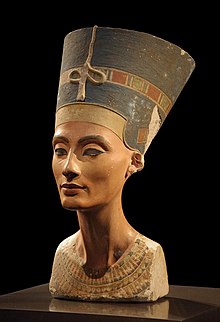
Back Borsbeeld Afrikaans تمثال نصفي Arabic Büst Azerbaijani Бюст (скульптура) Byelorussian Бюст (паметник) Bulgarian Bista BS Bust Catalan Busta Czech Buste (skulptur) Danish Büste German

A bust is a sculpted or cast representation of the upper part of the human body, depicting a person's head and neck, and a variable portion of the chest and shoulders. The piece is normally supported by a plinth. The bust is generally a portrait intended to record the appearance of an individual, but may sometimes represent a type. They may be of any medium used for sculpture, such as marble, bronze, terracotta, plaster, wax or wood.
As a format that allows the most distinctive characteristics of an individual to be depicted with much less work, and therefore expense, and occupying far less space than a full-length statue, the bust has been since ancient times a popular style of life-size portrait sculpture.
A sculpture that only includes the head, perhaps with the neck, is more strictly called a "head", but this distinction is not always observed. Display often involves an integral or separate display stand. The Adiyogi Shiva statue located in India representative of Hindu God Shiva is the world's largest bust sculpture and is 112 feet (34 m) tall.